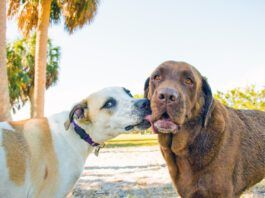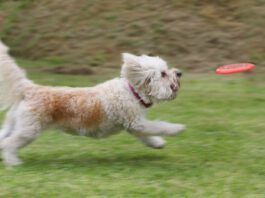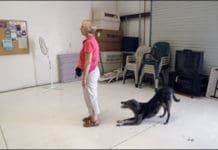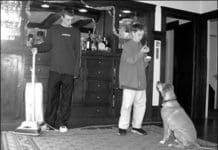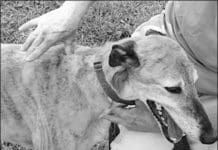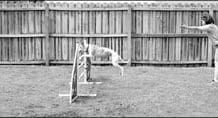Modifying Aggressive Dog Behavior
That loud buzz you hear is the sound of the dog behavior and training community discussing a controversial new approach to modifying aggressive behavior in dogs. The developers of "Constructional Aggression Treatment" (CAT) claim that the shaping-based operant protocol produces stronger and much faster results than the classical counter-conditioning process widely used by training and behavior professionals today. CAT was devised and tested by Dr. Jes¨²s Rosales-Ruiz, a behavior analyst and associate professor of behavior analysis at the University of North Texas, and Kellie Snider, a board-certified associate behavior analyst. Snider completed her MS in Behavior Analysis at UNT in 2007 with Dr. Rosales-Ruiz as her graduate research advisor and the CAT procedure as the topic of her thesis research. Canine behavior experts frequently use classical conditioning techniques (including counter-conditioning) to help change how dogs feel about and respond to the stimuli that triggers their aggressive behavior. In other words, classical counter-conditioning changes the dog's emotions in order to change his behavior. In contrast, CAT utilizes "operant conditioning," where the goal is changing the dog's behavior in a way that will likely produce a subsequent emotional change.
Uncommonly Calm Canines
Most dog owners are pleased when their dogs are calm - even the owners of high-energy competition and working dogs, when those dogs are "off-duty." Some owners may go to great - sometimes misguided - lengths to achieve the coveted calm condition. Humans who understand the appropriate way to help a dog learn to be calm can make the difference between the canine companion who finds a lifelong loving home, and the one who ends up - sometimes several times in his life - gazing sadly out from the chain-link kennels of an animal shelter. Calm is a highly valued, hard-won, and sometimes transitory state in our own household. With four dogs in the Miller pack, two of them proud representatives of the herding group, calm is something we have to work at. We use the time-honored recipe of exercise, management, and training (and of course, lots of love) to help our canine family members be a peaceable pack.
Analyzing Dog Behavior and Puppy Behavior
Hang with dog folks long enough and you're sure to hear some pretty interesting theories about dog behavior. Some are, of course, useful and accurate, but the dog training world is littered with myths, many of which are at least several generations old. Some of them are just silly; some have the potential for causing serious damage to the dog-human relationship; and still others are downright dangerous. It's time to get past the myths.
Canine Stimulus Control Through Positive Dog Training
Canine Charlie willingly sits on cue, but when clicks and treats don't come fast enough, he starts trying other dog behaviors in his repertoire - with rapid-fire offerings of shake, speak, down, and even a roll-over finding its way into the mix. He gets so excited about the dog training game that sometimes he doesn't even bother to sit first when asked, but drops right into the down - his favorite position. Charlie, an eager worker who loves positive reinforcement, has learned a lot of different behaviors and is anticipating his human's cues for all his favorite tricks. He clearly doesn't have his behaviors under stimulus control.
Dogs and Puppies Chew For a Number of Reasons, Learn to Properly Channel This...
between three and six months of age. While the baby teeth are shedding and the adult teeth are erupting
Modifying Your Dog’s Barking Behavior
Dogs bark for many reasons. If you want to modify your dog's barking behavior (either decrease it or increase it) it's helpful to know what kind of barking your dog is doing, how the behavior is being reinforced, and what to do about it. We'll discuss the various reasons dogs bark, and how each type of barking can be countered with positive training and smart management.
Dogs and Cats Living Together
You've no doubt heard the phrase fighting like cats and dogs." The media likes to play up stories about personality differences between "cat lovers" and "dog lovers
Reducing Your Dog’s Anxieties
President Franklin D. Roosevelt, speaking about the Great Depression, said, We have nothing to fear but fear itself." If only it were that simple when dealing with dog behavior! Fear-related behaviors can be debilitating to the inappropriately fearful dog. They are heartbreaking
Treating Canine Compulsive Disorders With Acupressure Techniques
Does a worried dog sing a worried song? A dog's worried song" is often expressed in quirky
Agility Games for Managing Dog Aggression
Owning an aggressive, fearful, or other type of special needs" dog is stressful. When your dog overreacts to other dogs or just the stimulus of being out in the world by barking
Does Your Dog Have an Eating Disorder?
Anorexia, bulimia, and weird pregnancy cravings are common in humans, but did you know dogs have eating disorders, too?
Involuntary Urination
When my dog Popcorn woke up one morning many years ago in a puddle of urine, I panicked, certain that only a deadly illness could cause this perfectly housetrained dog to wet her bed. I rushed her to the vet, where he did a thorough physical exam and urinalysis. I can still remember the relief I felt when my vet told me it appeared to be a simple case of incontinence. As it turns out, incontinence, which is defined as involuntary urination, is quite common in dogs, especially spayed females, where about one in five dogs (20 percent) is affected.



